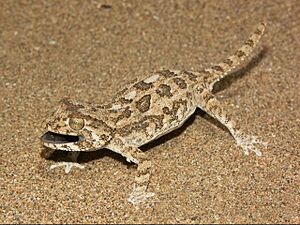Helmethead gecko facts for kids
Quick facts for kids Helmethead gecko |
|
|---|---|
 |
|
| Conservation status | |
| Scientific classification | |
| Genus: |
Tarentola
|
| Species: |
chazaliae
|
| Synonyms | |
|
|
The helmethead gecko (Tarentola chazaliae), also known as the helmeted gecko, is a type of lizard. It belongs to the Phyllodactylidae family. These geckos live along the northwestern coast of Africa. You can find them in countries like Mauritania, Morocco, and Western Sahara. They like to live in sandy and rocky desert areas close to the coast, where the air is quite humid.
Contents
What Does the Helmethead Gecko Look Like?
An adult helmethead gecko is about 7.5 cm (3.0 in) long from its snout to the base of its tail. Its total length, including the tail, is around 11 cm (4.3 in). The top of its head has many small bumps. Some larger bumps at the back of its head form a shape like a helmet, which gives the gecko its name.
Its toes are flat and wide, like spatulas. The gecko's back can be light grey or dark brown. It might be one solid color or have lighter or darker spots. Its belly is always light-colored.
Amazing Night Vision
The helmethead gecko is mostly active at night. While most lizards are active during the day, this gecko has special eyes. It can see colors even when it's very dark. This is because its eyes have adapted to low light.
It has a unique optical system that helps it see different colors of light. During the night, its pupils are round. But during the day, they change into two tiny pinhole-like openings in each eye. Scientists are not sure why this happens. One idea is that the small pupils might make it harder for predators to spot the gecko when it's resting in the sun.
Helmethead geckos are the first known animals with backbones that can see color in very dim light. Their night vision for color is an amazing 350 times better than a human's!
Where Did Its Name Come From?
The scientific name, chazaliae, honors a yacht called Chazalie. This yacht belonged to a French naturalist named Raymond Comte de Dalmas. He was the one who first collected this gecko. The common name, helmethead gecko, comes from the helmet-like shape of the scales on the back of its head.
Is the Helmethead Gecko in Danger?
The helmethead gecko lives in a fairly small area. People sometimes collect these geckos to keep as pets. Their natural home is also being damaged by new buildings along the coast, especially in Morocco.
Because of these problems, the number of helmethead geckos is going down. The International Union for Conservation of Nature (IUCN) has listed this species as "vulnerable". This means it is at risk of becoming endangered if things do not change.



